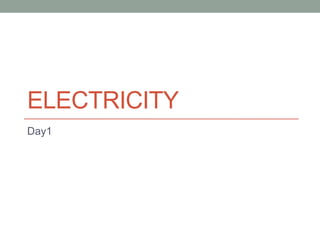
Discover How Electricity Works in Just 40 Characters
- 2. Goals for the Lesson • Discuss how electricity is created and benefits it bring to society. • Understand the principles of electricity and the terms used when discussing electricity • Be able to state Ohms Law and its formulas. • Use a multimeter to measure voltage and resistance.
- 3. What is Elecricity • Definitions • noun • any phenomenon associated with stationary or moving electrons, ions, or other charged particles • the science concerned with electricity • an electric current or charge ⇒ a motor powered by electricity • emotional tension or excitement, esp between or among people • http://www.collinsdictionary.com
- 4. Current Flow Electricity is the flow of electrons and this flow of electrons is called electric current. The current flows from negative to positive but due to a lack of understanding about electricity when it first was discovered it was thought it flowed from positive to negative this idea was kept and we call it the conventional current flow
- 5. Conductors & Insulators • Conductors allow current • Insulators prevent current to flow through them flowing through them easily example copper, plastics, wood and rubber aluminium, gold metals are example of good are good conductors insulators
- 6. Power source A power source is required to push the electron around a circuit. The force that pushes the electrons are called volts symbol (V ). The power source can be mains supplied which is Alternating current AC or battery powered Direct Current DC. Alternating current changes from positive to negative in waves called cycles, the ESB supplies alternating current at 220 volts and 50 cycles a second. Direct current flow in the same direction all the times, this is the type of current is stored in a battery
- 7. Ohms Law When we talk about electricity These three values are it has a relationship between expressed in ohms law which three values voltage, current states that: and resistance. The current flowing through a Voltage is the force electrons conductor is proportional to the are pushed around a circuit potential difference across it symbol (V ) units volts provided the temperature stays Current is the rate or speed the same. This can be the electrons move symbol (I) expressed as a formula units ampere (A). Resistance this is the ability of some conductors to resist the flow of electrons, this allows us to control the flow symbol R units ohms Ω
- 8. Ohms Law Example Question What is the resistance of a resistor that has a voltage drop of 9.35V and a current of 0.55mA
- 9. Multimeter A multi meter is a device which can measure voltage, current, resistance and check for breaks in circuits.
- 10. Activity In pairs find the resistance for the resistors given? Home work Study work sheet you completed in class. Complete activity on blog in relation to ohms law. Find and post back on blog most interesting fact you can find on electricity.